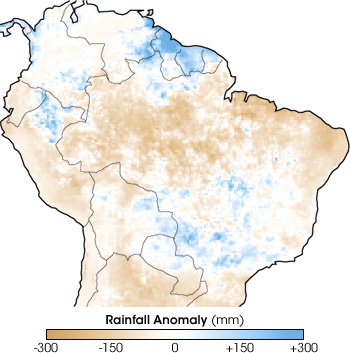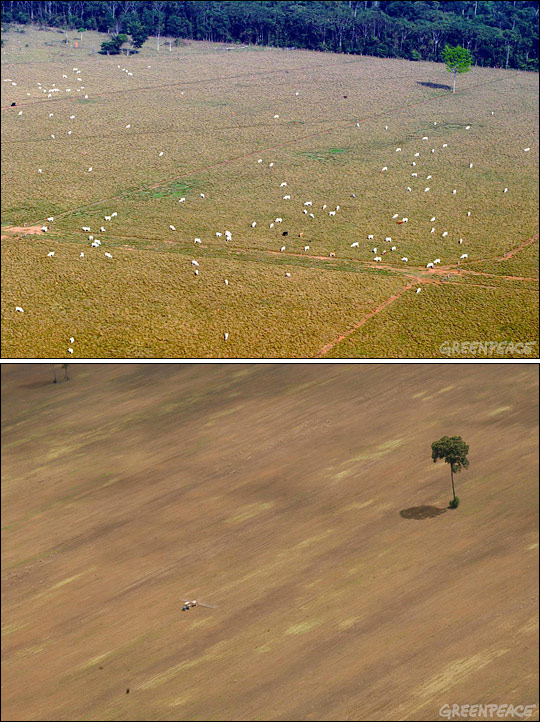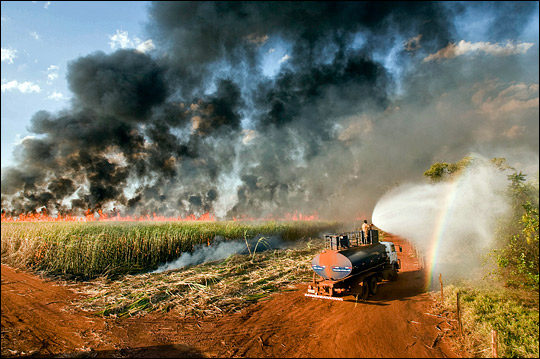

Burning Falls in 2006, Rises in 2007 | |||
The dramatic drop in fires and smoke in 2006 may partly result from the devastation of 2005. Koren and his colleague Lorraine Remer collaborated with Karla Longo, a scientist at the Brazilian Center for Weather Forecasting and Climate Studies, who explained that in 2005, the annual dry season in Peru, Bolivia, and southwestern Brazil had ballooned into an unrelenting drought. Agricultural fires on the Amazon frontier invaded adjacent forests on a large scale. |
|||

The urgent situation spurred unprecedented collaboration between government agencies, civil organizations, and scientists to identify and control fires. The success of this initiative may have carried over in 2006. For example, for 75 days in 2006, the Public Ministry of Acre prohibited burning in eastern Acre, where the damage from out-of-control fires in 2005 was especially severe. The Amazon in the Global MarketplaceSuccessful regulation is probably not the whole story, however. Several scientists, journalists, and environmental groups have pointed out the link between Amazon deforestation rates and the price of global commodities, mostly soy and beef. In the 1980s and 1990s, much of the deforestation in the Amazon resulted from many small clearings by subsistence farmers. But increasingly, deforestation is driven by industrial-scale cattle ranches and to a lesser extent, soy farms. Regulation and cooperation for controlling fires may have stepped up in 2006, but the price of soy was also down, lessening the economic incentive to clear forest for soy farms. |
The dry season of 2005 marked the end of an intense, multi-year drought. In January—the rainiest month of the year in much of the western Amazon—precipitation was far below average (brown areas) across much of the Amazon basin. Many agricultural and land-clearing fires got out of control and damaged nearby rainforest. (Map by Robert Simmon, based on Tropical Rainfall Measuring Mission (TRMM) data from the Goddard DAAC.) | ||
 | |||
The fingerprint of the global market’s influence on Amazon deforestation seems to have been left on the 2007 fire season, as well. After the 2006 lull, the fires and smoke in 2007 were worse than any year in Koren’s 1998-2006 study period. Via email, William Laurance, of the Smithsonian Tropical Research Institute, wrote, “Most folks are attributing the heavy deforestation in late 2007 (or more specifically, the high incidence of fires) in places like Mato Grosso and Para [states in southern Brazil] to high soy and beef prices.” |
Increasingly, Amazon deforestation is the result of industrial-scale cattle ranches (top) and soybean plantations (below), rather than small farms. (Photographs © 2004 Greenpeace/Alberto Cesar and © 2006 Greenpeace/Nilo D’Avila.) | ||
 | |||
Sugar Cane ControversyKoren says another possible—and more controversial—reason for the increased burning could be that Brazilian farmers have stepped up sugar cane production in response to the global boom in the biofuels market. Ethanol fuel is made from the sugar in the plants’ tall, bamboo-like stems. To make harvesting easier, which reduces manual labor costs, sugar cane fields are burned prior to harvest to remove the plants’ leaves. Many growers have agreed to phase out burning over the next decade. Until the switch to mechanized harvest is complete, however, smoke pollution will continue to be a problem in Brazil’s sugar cane growing region. The industry is well established in the savannas and grasslands south of the Amazon, where the climate and soil are more suitable for sugar cane cultivation. |
Koren and his colleagues measured increasing concentrations of smoke over the Amazon from 2000 to 2005, followed by a big drop in 2006 and a dramatic spike in 2007. (Graph by Robert Simmon, based on MODIS data from Ilan Koren.) | ||
 | |||
In news reports, Brazilian President Luiz Inacio Lula da Silva has dismissed the possibility that growth in sugar cane production for biofuels is causing significant new deforestation in the Amazon Rainforest, citing the unsuitable climate. Even so, Koren thinks, it’s possible that previously cleared lands—cattle pasture or soy farms—along the southern Amazon frontier were converted to sugar cane in 2007, contributing to more fires and smoke. Hope for the AmazonDespite the upswing in fire activity in 2007, the 2006 drop offers hope that a combination of effective regulation and market-based incentives for conservation will allow Brazil and other Amazon countries to improve their economies without sacrificing a crucial ecological and climate-stabilizing resource. It is those moments of hope that keep Koren motivated, despite the fact that the career he has chosen makes him intimately familiar with so many of the world’s worst environmental problems. |
Sugar cane is widely grown for biofuel in southern and southeastern Brazil. To reduce labor and processing costs, the leaves of the plants are burned off prior to harvest of the canes. Whether the increase in fires and smoke in 2007 could be tied to the conversion of forest or existing agricultural land into sugar cane plantations for biofuel has been a controversial question. (© 2007 UN Photo by Eskinder Debebe.) | ||
 | |||
“You do see depressing things. But you just try your best to show people what is happening [in the world] and influence things the best you can. Then you just have to be optimistic. You know, there is a very strong link between scientists and artists. The link is that you have to be very creative, always trying to ‘think outside the box.’ And you are not paid well,” he says with a laugh. “Which means you really have to love it.”
|
After falling off in 2006, fires and smoke increased again in 2007, perhaps spurred by increases in cattle and soybean prices on the global market. Smoke completely covers thousands of square kilometers in this MODIS image acquired September 9, 2007. (NASA image by Jesse Allen and Robert Simmon, based on data from MODIS.) | ||